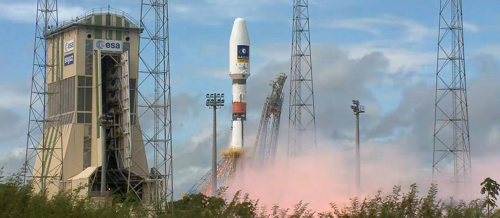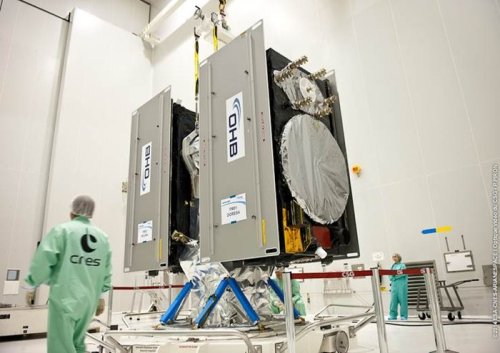
(The satellites’ successful lift off – Photo Credit: ESA/Arianespace)
On August 22nd, a Soyuz VS09 rocket launched two Galileo navigation satellites from the European Space Agency’s spaceport in Kourou, French Guiana. The rocket was scheduled to propel the duo into medium-Earth orbit, however the ESA have now confirmed that an anomaly occurred during flight and the satellites were not inserted into their correct trajectories.
The satellites, called Doresa and Milena, faced a 24 hour launch delay due to bad weather, however the postponed launch and first stage of the mission proceeded nominally and the satellites were separated and released from the rocket according to schedule.
However, telemetry stations operated by the ESA and the French space agency, CNES, have now confirmed that the satellites are not in their expected orbit.
“Observations taken after the separation of the satellites from the Soyuz VS09 for the Galileo Mission show a gap between the orbit achieved and that which was planned,” said Arianespace, the launch service provider, in a statement.
 (Artist’s concept of the satellites – Photo Credit: ESA)
(Artist’s concept of the satellites – Photo Credit: ESA)
The duo’s targeted orbit was circular, inclined at 55 degrees with a semi major axis of 29,900 kilometers but the satellites are actually in an elliptical orbit, inclined at 49.8 degrees with a semi major axis of 26,200 km.
“Our aim is of course to fully understand this anomaly” announced Stéphane Israël, Chairman and CEO of Arianespace. “Starting Monday, Arianespace, in association with ESA and the European Commission, will designate an independent inquiry board to determine the exact causes of this anomaly and to draw conclusions and develop corrective actions that will allow us to resume launches of Soyuz from the Guiana Space Center (CSG) in complete safety and as quickly as possible.”
“The board will coordinate its work with Russian partners in the Soyuz at CSG program. Arianespace is determined to help meet the European Union’s goals for the Galileo program without undue delay. We would like to thank ESA, the European Commission and CNES for the very productive discussions since becoming aware of the occurrence of the anomaly. While it is too early to determine the exact causes, we would like to offer our sincere excuses to ESA and the European Commission for this orbital injection that did not meet expectations” Israël added.
 (The Galileo satellites – Photo Credit: ESA/Arianespace)
(The Galileo satellites – Photo Credit: ESA/Arianespace)
The satellites are in a position that entails absolutely no risk for people on the ground. Both satellites, although in the wrong orbit, are being safely controlled and operated from the ESA’s Operations Centre in Darmstadt, Germany.
Further information on the status of the satellites will be made available after a preliminary investigation into the situation is conducted. Studies and further data analysis will continue until the scope of the anomaly, and its impact on the mission, is determined.
You can view a replay of the Galileo launch below:
[Video Credit: ESA]